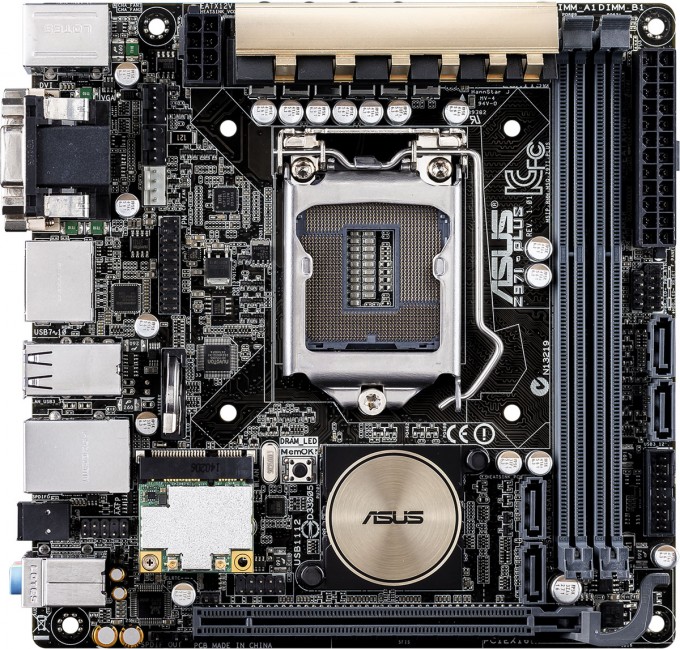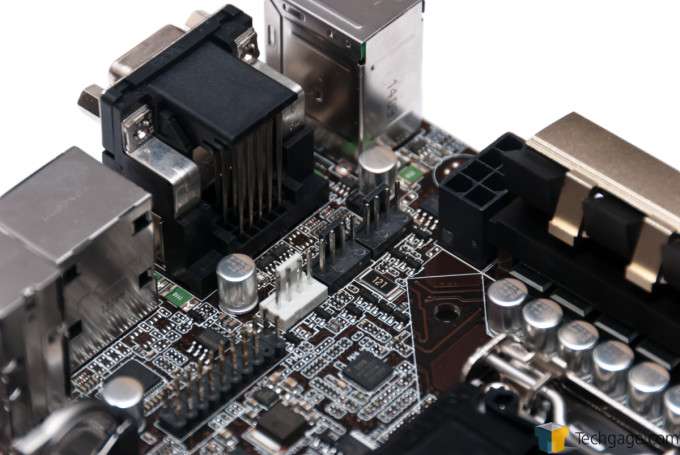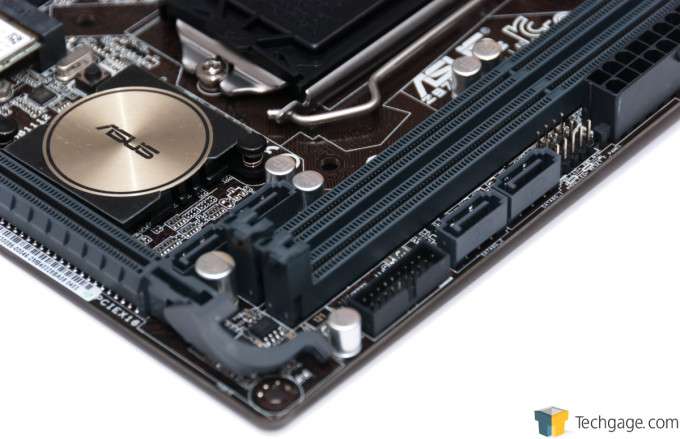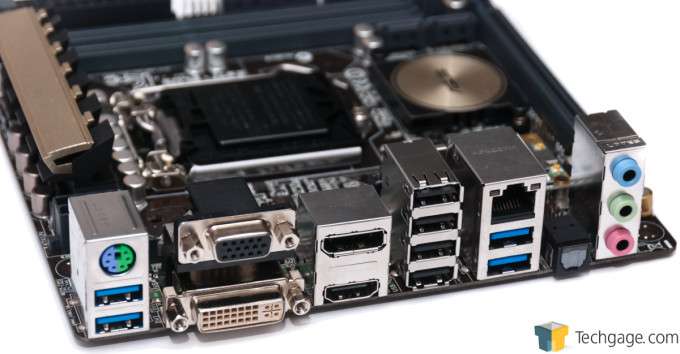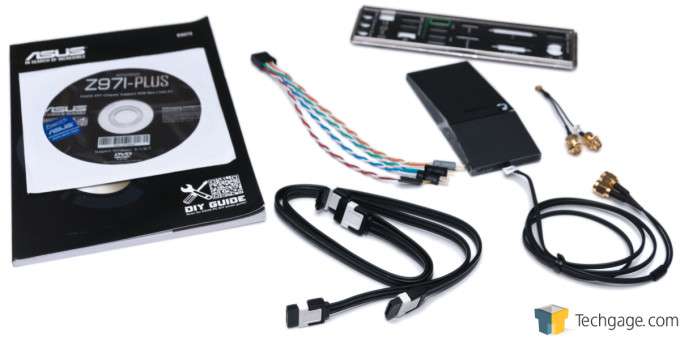- Qualcomm Launches Snapdragon 4 Gen 2 Mobile Platform
- AMD Launches Ryzen PRO 7000 Series Mobile & Desktop Platform
- Intel Launches Sleek Single-Slot Arc Pro A60 Workstation Graphics Card
- NVIDIA Announces Latest Ada Lovelace Additions: GeForce RTX 4060 Ti & RTX 4060
- Maxon Redshift With AMD Radeon GPU Rendering Support Now Available
ASUS Z97I-PLUS mini-ITX Motherboard Review

“Big things come in small packages” might be cliche, but it applies well to mini-ITX motherboards – especially those like ASUS’ Z97I-PLUS. Featuring 802.11ac wireless, an M.2 slot, a common-sense design, and a fantastic software package, this is one board well worth considering for that next ITX build.
Page 2 – A Hardware Tour of ASUS’ Z97I-PLUS
With its mini-ITX form-factor, ASUS’ Z97I-PLUS measures 6.7″ x 6.7″. It’s no doubt obvious, but because mini-ITX boards are so small, they’re best-suited for chassis that are specially-designed with them in mind.
You don’t want to be known as a person who installs a mini-ITX board in a full-tower chassis with a 140mm CPU cooler, do you? Me, either. That would kind of be like parking a row boat at a marina.
To start the hardware tour, we’ll refer to an ASUS-provided stock image, which I’ve verified matches up with the retail unit. As with all other motherboards, the first thing I looked into was the number of fan headers. All too often, 2 is deemed sufficient on ITX offerings, but ASUS was kind enough to give us 3 to work with. That should prove useful to those who want to put a huge CPU cooler with two fans on their modestly-sized motherboard, or those with larger chassis that support more than one fan.
ASUS’ Z97I-PLUS is the first ITX board I’ve used in a while, and installing it reminded me of a couple of things. For starters, it’s important to plan the build process out in your head before you install the board into its chassis, because it’s really inconvenient to backtrack and have to uninstall things.
Let me explain what I mean: All three of the board’s fan headers, for example, are located at the top-left. Because I was using a large CPU cooler, I had a difficult time plugging in its fans. Had I plugged them in before I installed the board, things would have been a lot simpler. The 2 SATA ports above the PCIe slot should also be noted; if you plan to occupy more than 2 ports, you’ll want to plug in all of the SATA cables you’ll need before installing the graphics card. Once the board, CPU cooler, and GPU are installed, the amount of space you have to work with is really minimal. Of course, that simply comes with the ITX territory.
Other things to note is that this board doesn’t have an onboard power button, which is a feature I’ve come to appreciate on any board. However, that’s not really that common on ASUS’ mainstream line, while it is on the RoG side of things (the ITX Impact does have one). There’s also no LED BIOS readout here, but I am not sure anyone actually expected there to be. With ITX’s incredible constraints, vendors like ASUS have to be extremely careful about what features to include, and which to omit.
While there’s no onboard power button present, there is a MemOK! button. The purpose of this is to boot the system when the RAM is causing compatibility issues, and while the button isn’t at the edge of the motherboard, a screwdriver should be able to easily reach it. It’s also worth noting that the CMOS battery stands up on this board; it’s found to the left of the CPU socket in this image. If you happen to remove this battery, take note of the sides – you can install it backwards. I might have figured that out during testing.
In the specs table on the previous page, it’s noted that the H97I-PLUS includes a mini-PCIe slot while the Z97I-PLUS doesn’t. However, this board actually does include one; it just happens to be preoccupied with its Wi-Fi duties.
With that, let’s get into some more photos.
As mentioned before, the board’s 3 fan headers are located to the top-left of the board, underneath its 8-pin power port. Ideally, I prefer to have that port horizontally placed, but given the size constraints here, and the fact that I had no problem plugging that cable in, that’s hardly an issue here.
At the bottom-right hand corner, we find the 4 SATA ports the board offers, as well as the USB 3.0 internal header. If a USB 2.0 internal header is needed, one can be found above the GPU, to the left of the ASUS heatsink.
The Z97I-PLUS might be a small board, but it features a full-sized I/O panel. Thanks to that, there are 8 USB ports available (4x 2.0; 4x 3.0), four different video connectors, S/PDIF output and 3 speaker ports, the LAN port, and for good measure, a PS/2 KB/mouse port.
On account of the fact that there’s rarely anything of note on the back of a motherboard, I don’t often include photos of them. However, this board is different: Underneath the CPU socket is the M.2 slot, suitable for SSD storage, and targeting those building seriously space-sensitive builds. At current market pricing, M.2 SSDs can be had for about $80, providing 128GB of storage.
In the box, ASUS provides 2x SATA cables, the antenna for Wi-Fi, the back I/O panel, chassis connector extender, and of course, the manual and driver DVD.
Before moving onto the next page, I have to say that I think ASUS has done a great thing by including the chassis connector extender with this board. Had this not been included in the box, I would have had a not-so-fun experience trying to plugging in these cables, due both to the tight squeeze, and lack of slack on the cable. Once you plug this cable into the port on the motherboard, connecting the chassis connectors is an absolute breeze, as seen in a shot I shared earlier.
Time for some focus on the EFI.
Support our efforts! With ad revenue at an all-time low for written websites, we're relying more than ever on reader support to help us continue putting so much effort into this type of content. You can support us by becoming a Patron, or by using our Amazon shopping affiliate links listed through our articles. Thanks for your support!




